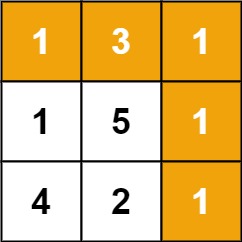64. Minimum Path Sum
Given a m x n grid filled with non-negative numbers, find a path from top left to bottom right, which minimizes the sum of all numbers along its path.
Note: You can only move either down or right at any point in time.

Constraints
- m == grid.length
- n == grid[i].length
- 1 <= m, n <= 200
- 0 <= grid[i][j] <= 100
Concept
The idea is similar to Unique Paths problem, but we use a two dimension array with size m+1 x n+1. The reason that adding one to m & n is to compare value between extended cell with incoming grid. What we do to find out the solution is implement as below:
- Create a two dimension array
a[m+1][n+1] - Initialize the last row and column to all
INT_MAX. (Here is a common straegy to find out the minimum from two values.) - Set
a[m][n-1]to zero because we want to get the smallest value in the first time. - Iterate cell starting from the last cell in the grid.
- Find out the smaller value from the two adjacent nodes(right/down) and plus current cell. Repeat this step until we reach the first cell in the grid.
- The final answer is in
a[0][0]
Complexity
Time Complexity
O(m*n): We iterate the table, the size of table is m rows multiplies n * columns.
Space Complexity
O(m*n): An extra space to hold the value when calculating the minimum path.
Code
class Solution {
public:
int minPathSum(vector<vector<int>>& grid) {
/** 2022/1/7 -- 8ms, 9.8mb; O(m*n), O(m*n); DP, Copy cat */
int m = grid.size(), n = grid[0].size();
int rec[m+1][n+1];
for (int i=0; i<n; i++)
rec[m][i] = INT_MAX;
for (int i=0; i<m; i++)
rec[i][n] = INT_MAX;
rec[m][n-1] = 0; // Either `rec[m][n-1] = 0` or `rec[m-1][n] = 0` could let the min() work.
for (int i=m-1; i>=0; i--) {
for (int j=n-1; j>=0; j--) {
rec[i][j] = grid[i][j] + min(rec[i+1][j], rec[i][j+1]);
}
}
return rec[0][0];
}
};